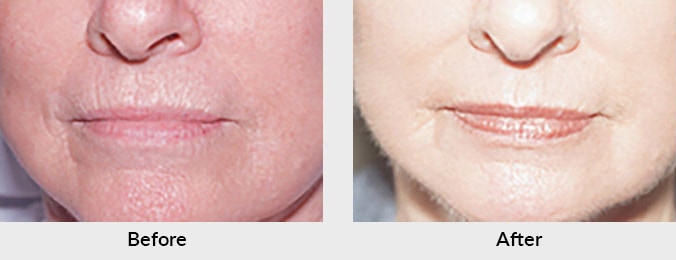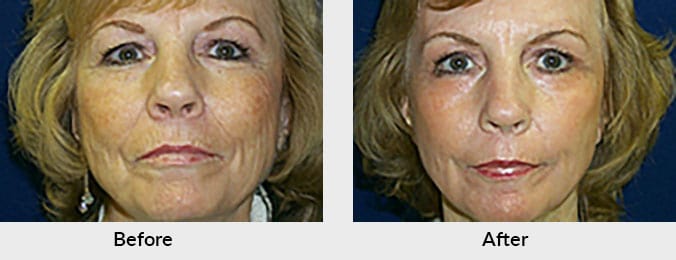Skin is made up of an outer epidermis of skin cells and an underlying dermis make-up of the building blocks of skin, i.e. collagen, elastic fibers, water, blood vessels, glands, and glycosaminoglycans. All skin treatments are based upon several concepts: (1) speeding up epidermal cell turnover rate, (2) thickening the dermis and (3) stop the breakdown of the skin with antioxidants and skin protection with sunscreen.
The life span of a single epidermal cell that you feel when you touch the skin is approximately ten days. During this time the cell is exposed to environmental trauma that damages the outside of the cell. By the end of the tenth day, the cell has enough surface damage that together with similar effects on millions of surrounding skin cells, the skin has a very rough feel. If medicine like Retin-A or glycolic acid can produce a more rapid turnover rate so that the cells are pushed off the body in five days, rather than ten days, then the cells will not be exposed to as much trauma. These cells will then feel softer when they are replaced by new, undamaged cells. It’s that simple.

Another way Retin-A and glycolic acid work is that by stimulating the dermis to make more epidermis, the dermis becomes thicker itself. And a thicker dermis has more blood vessels for a pink glow, more elastic fibers for more recoil, more new collagen for volume to remove wrinkles, and more water content to plump up the skin. These are all qualities for youthful skin that we lose as we age. Newer science now recommends retinol rather than Retin-A just to increase the speed of the epidermal cell turn over and thicken the epidermis. The dermis itself is better stimulated with polypeptides that turn the cellular building blocks on more efficiently with less irritation than the older Retin-A.
Procedure Differences
The difference between Retin-A, retinol, and glycolic acid and the stronger trichloroacetic acid (TCA) chemical peels or croton oil peels is the depth of penetration. The deeper the treatment into the dermis, the greater improvement of the skin. The downside of a deeper treatment is, of course, a greater risk of scarring and much greater healing time. Retin-A, retinol, and glycolic acid barely penetrate the dermis; therefore, do little to thicken the dermis. The effects are to remove fine lines, improve superficial color irregularities and make softer skin. Medium to deep wrinkles and deep color irregularities will not be improved, but the recovery time is zero and there is essentially no risk. Microneedling is a minimally invasive technique that produces a clinical improvement of fine lines medium lines and enlarged pores with three treatments. The good news is that it works and that the downtime is zero.
If one wants to improve deeper wrinkles, deep color problems, or acne problems, deeper penetration into the dermis with TCA, dermabrasion, or laser must be used. All of these agents produce damage to the dermis, removing old damaged skin elements and regenerating them with new collagen, new elastic fibers, increased water, and more blood vessels. The recovery time is increased with deeper treatments. The skin will be completely healed anywhere from one to two days for light penetration, and from ten to fourteen days for deep treatments.
If all the treatments remove dermis, why is one technique better than another? Dermabrasion removes the dermis by mechanically sanding away tissue whereas laser removes the dermis by vaporization of the tissue. Chemical peels remove the dermis by chemical damage. Each technique does the same thing but in a different way. A laser using “Fractional” technology employs lasers to partially treat skin to produce an overall skin change. For example, the HALO fractional laser uses ablative or non-ablative light to just a third of the area to be treated. This produces an effect on the entire skin’s surface, though only a fraction was treated. The treated areas’ rejuvenating effects spill over into the skin areas immediately adjacent but not directly treated, thereby rejuvenating all the skin while only actually treating a fraction of the skin. Ablative lasers require one to two treatments and have 3-4 days of downtime post-treatment. Non-ablative lasers require 4-6 treatments but have only a day or two of down-time. These treatments produce mild to moderate improvement. The latest technology comes with a greater expense. We offer this technology but find many patients choose chemical peels for their effectiveness, safety, and lower cost. For superficial or deep treatments, chemical peels are safe, inexpensive, and effectively produce moderate skin changes.
Skin Resurfacing Recovery
The recovery for each treatment is also similar. Because the outer layers have been removed, the wound is similar to a burn. The treated area is kept moist with Vaseline or other creams to protect the fragile dermis from drying out. As long as the dermis is covered, there is very little discomfort. Some doctors prefer a tape-like dressing which works satisfactorily, but we find it cumbersome and prefer the open method.

After the skin has completely healed and there is no fluid weeping, the skin will appear very shiny, very red and feel somewhat rough. We begin Vitamin C to reduce redness and start moisturizers as the new skin will feel dry. Sunscreen is an absolute requirement for the next three months. Makeup can be worn from now on. A special red away makeup can be purchased that will minimize the normal post-op redness that comes from healing. The redness will gradually fade over the next four to eight weeks. As the skin matures, the initial rough feel will resolve into very soft skin. As with any surgical procedure, there are potential complications. These can be minimized by strictly following post-op instructions and calling our office for any questions. The biggest concern of most patients is that the treatment does not go too deep and leave a full thickness scar. Because we are very aware of this remote possibility, we are extremely careful to remain on the conservative side of skin treatment depth. We would rather have to perform two medium depth treatments than one deep depth penetration and risk a permanent scar.
Bacterial infection is rare. We do begin prophylactic antiviral medicine three days pre-op to prevent the 2-3% chance of a cold sore developing, even in people who have never had a sore before.
Other common side effects are milia, which are small white bumps that are easily removed with a mildly abrasive washcloth. Everyone will be red for at least six weeks, longer for those with deeper treatments. Itching is common with healing and is treated with cold compresses and Benadryl.
Later side effects can be hyperpigmentation or brown discoloration. This tends to occur in darker skinned people and responds well to daily retinol and a bleaching agent called hydroquinone. Often these agents are begun two weeks pre-op to minimize the risk of post-operative color changes. Hypopigmentation or lighter pigmentation can occur when the penetration has been very deep. This is a 1-2% phenomenon.
Strategy for Better Skin
Our strategy for better skin is to avoid smoking, expose the skin only to moderate amounts of sun, and always use sunscreen. Retinol, topical vitamin C antioxidants, polypeptides in the SkinPrint, and ZO Medical programs are effective ways to maximize the skin’s potential in a risk-free fashion with no downtime. But if the skin has deep wrinkles, severe sun damage, or deep acne scarring, more aggressive chemical peels or laser therapy is needed. As the depth of penetration increases, the results are more dramatic but with a longer recovery phase. For patients who are serious about improving their skin, we have an effective program for every level of motivation and degree of skin damage.



